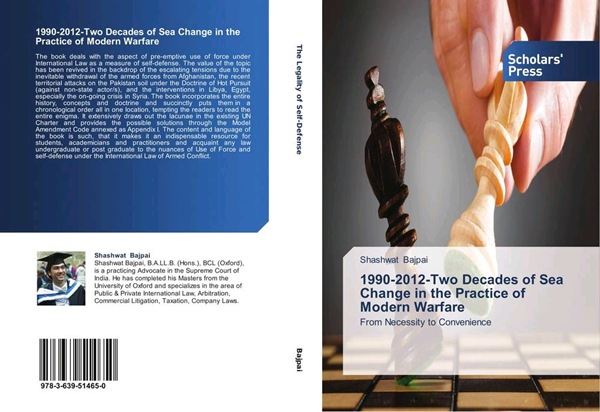
Oxford University 2012 BCL graduate and practicing Supreme Court advocate Shashwat Bajpai attempts to unravel whether states have the right under international law to use pre-emptive force for self-defence, especially in light of events that occurred in the decade since 9/11.
Bajpai’s research deals with such concepts as the difference between “pre-emptive”, “preventive” and “anticipatory self defence”. He also addresses the misuse of the United Nations Security Council’s veto power, the limits of justifiable external intervention, and how the boundaries of self defence as defined by ancient International Court of Justice case law have continued extending. In its longest chapter, the book deals with the doctrine of hot pursuit – 70 wholesome pages justly dedicated to the fascinating doctrine, which also includes the Osama Bin Laden killing by US forces.
One chapter in the book specifically examines the “Bush administration of pre-emptive warfare”, and takes a look at the 1990 Kosovo intervention, the 1991 Gulf War, 2001’s “Operation Freedom” in Afghanistan and the 2011 Libya intervention.
Another chapter focuses entirely on the use of force by the Anglo-American alliance in Iraq and whether it was proportional to the assumed threat. Bajpai has also presented an analysis of the justifications presented to the UN Security Council in making the case for bombing Iraq for their own apparent self defence. A tight narration of the historical background leading up to any major event is usually the best form of argument for or against the justifiability of that event. The contextual research and back-stories to the US’ and UK’s use of force are exhaustive, and the chapter makes up in reportage what it lacks in detailed legal reasoning.
With a detailed discussion of the US’ National Security Strategy (NSS) in the so-called global war on terrorism, the chapter highlights how certain states wrongly assume the right to wage wars on entire nations based only on presumptions, conjectures and surmises that terrorists are taking refuge within those target nations. With some help from the context that historical chronology provides, we are able to understand the actual twisted motives behind such use of force.
What Bajpai is getting at with each chapter in his thesis is that the UN charter’s provisions are simply not equipped to deal with the changing nature of preemptive warfare. He uses the instances of abuse of the charter to draw out the lacunae in its current provisions, and then eventually present his own “Model Amendment Code”. At the end of the book Bajpai has annexed his Draft Model UN Charter Amendment Code, which suggests some key changes in the UN Charter based on a consideration of the conclusions drawn in the book’s chapters.
The strongest feature of the book is that it gives a nearly exhaustively picture of the chronological cause and effect of international pre-emptive warfare. The book dockets all historical references since the 1920 League of Nations to date, which go a long way in giving context to modern pre-emptive warfare as it stands – and that it is chronologically bound together in a single cover gives it major utility to the interested reader.
Published by Scholar’s Press, Bajpai’s 408 page debut title is priced at Rs 6,000 (74.90 €).
threads most popular
thread most upvoted
comment newest
first oldest
first
threads most popular
thread most upvoted
comment newest
first oldest
first